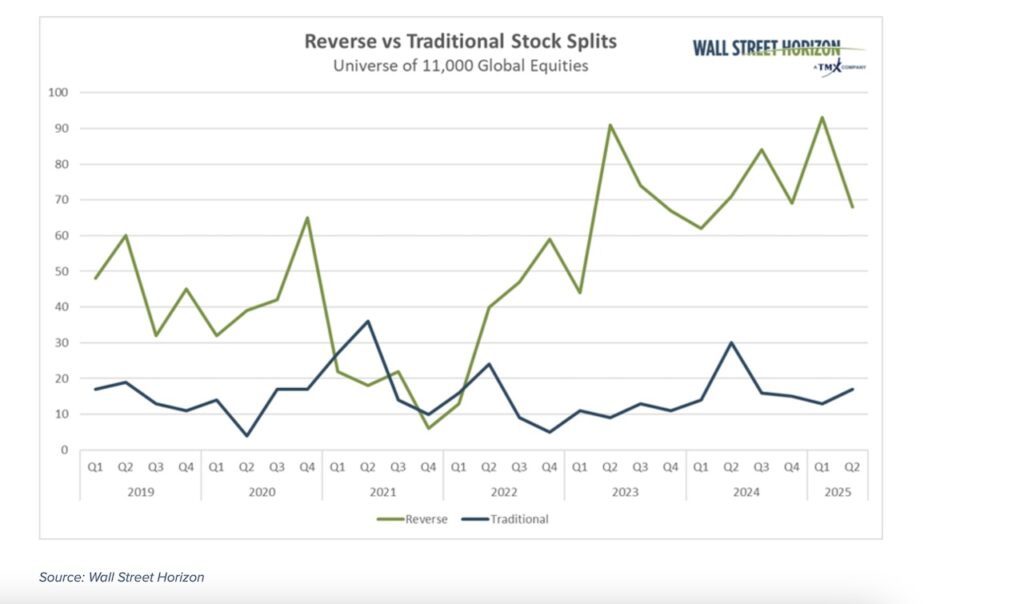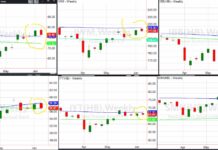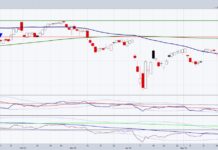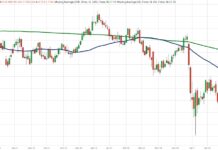- Reverse stock splits, possibly indicating corporate distress, hit a 10-year high in Q1 2025
- The reverse-to-traditional split ratio also surged in Q1 2025
- This trend began to taper in May, suggesting improving corporate health
As we head into the second half of the year, US markets seem to be turning around, with economic data that is still coming in mixed. The major US indices were up the first three days of last week, dipping on Thursday after weaker back-to-back readings of the US labor market.
The ADP report showed private payrolls added just 37,000 jobs in May, well below the Dow Jones consensus for 110,000.1 The following day, initial jobless claims for the prior week came in at 247,000, compared to the consensus estimate of 236,000 from economists polled by Dow Jones.2
On Friday markets were relieved by a more uplifting Nonfarm Payrolls report that came in at 139,000, higher the estimate for 125,000, but lower than April’s 147,000. Unemployment remained unchanged at 4.2%.3 Even consumer confidence as tracked by The Conference Board, saw its highest reading in May after five consecutive months of declines.4 Certain corporate events seem to be following suit.
Reading the Tea Leaves of Corporate Health through Stock Splits
A good read on overall corporate health can be found in reviewing splits data, and the ratio of reverse-to-traditional stock splits. Reverse stock splits consolidate the number of existing shares, therefore making them higher-priced, companies often do this when their stock price has dropped dramatically and they are in danger of being de-listed from an exchange.
On the other hand, traditional splits increase the number of shares in the marketplace, which lowers the price of each share. Companies typically do this when their stock price has catapulted to record levels which make it unaffordable to retail investors. They would employ a traditional split to increase liquidity and make their shares more accessible.
Q1 2025 Recorded the Largest Number of Reverse Stock Splits in a Decade
Q1 2025 had the highest number of reverse stock splits in nearly 10 years, coming in at 93. That trend continued in April when 37 companies announced reverse stock splits, the second highest monthly total in our data history going back to 2016. Economic headwinds such as fluctuating trade policy and softening consumer spending lead US markets to dip in the first quarter. By early April, the DJIA was down 12%, the S&P 500 fell 15% and the Nasdaq was down over 20%. Many companies performing these reverse splits saw their stock price fall dramatically and did this as a way to boost that price.
The good news is the reverse stock split trend started to taper in May with 30 such splits announced, more on trend with typical recent monthly totals. We’re only a few days into June at this point, but there are 2 reverse splits thus far.

Not only are reverse split totals high thus far in 2025, but so is the reverse-to-traditional split ratio. In the last decade that ratio has averaged 3.43, meaning for every one traditional split there were slightly more than three reverse splits. In Q1 2025 that ratio hit 7.15, falling to 4.05 so far in Q2. That’s still historically high but showing signs of reverting back towards the norm.
The Bottom-line
We’ll be keeping our eye on what corporate events are signaling to us about economic conditions as the second half of 2025 approaches. These events and often their timing can be imperative to learning more about the health of companies and the current macro landscape. Reverse splits are just one example of a corporate action companies can take to bear the brunt of a whipsawing markets like we saw earlier this year.
Sources:
1 May ADP® National Employment Report, June 4, 2025, https://adpemploymentreport.com/
2 Unemployment Insurance weekly Claims, Department of Labor, June 5, 2025, https://www.dol.gov
3 May Employment Situation Summary, US Bureau of Labor Statistics, June 6, 2025, https://www.bls.gov
4 “US Consumer Confidence Partially Rebounds in May,” The Conference Board, May 27, 2025, https://www.conference-board.org
Twitter: @ChristineLShort
The author may hold positions in mentioned securities. Any opinions expressed herein are solely those of the author, and do not in any way represent the views or opinions of any other person or entity.








